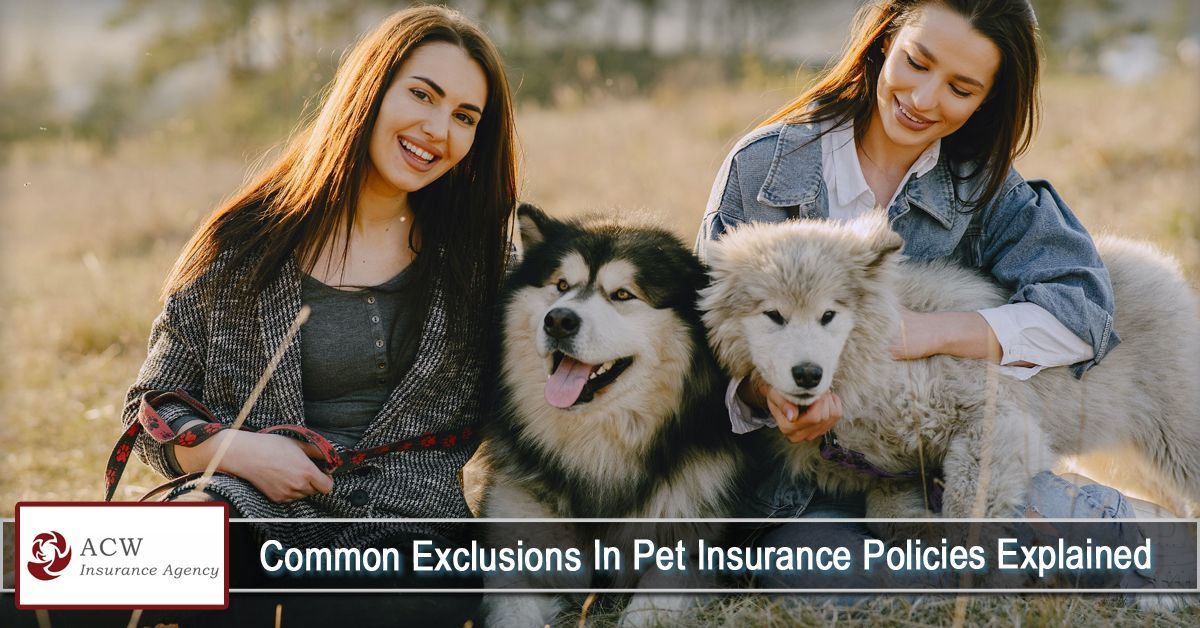
For many pet owners, furry friends are more than just animals—they’re beloved members of the family. And just like any family member, they deserve protection and care when health issues arise. That’s where pet insurance comes in.
Pet insurance helps offset the cost of veterinary care, giving owners peace of mind during emergencies or unexpected illnesses. However, not all conditions or treatments are covered. Understanding the common exclusions in pet insurance policies can help you avoid surprises when filing a claim and ensure you choose a plan that truly meets your pet’s needs.
Understanding How Pet Insurance Works
Pet insurance operates similarly to human health insurance: you pay a monthly premium, and when your pet needs medical care, the insurance company reimburses part of the cost after you pay a deductible.
However, pet insurance typically works on a reimbursement basis, meaning you pay the vet bill upfront and then submit a claim for partial reimbursement.
While most plans cover accidents, illnesses, and emergencies, each provider defines its own coverage terms—and exclusions.
What Are Pet Insurance Exclusions?
An exclusion refers to a condition, treatment, or circumstance not covered by your policy. Exclusions vary by company and plan, but they generally include pre-existing conditions, specific procedures, or optional services that fall outside basic medical care.
Understanding these exclusions before enrolling your pet ensures you won’t face unexpected out-of-pocket costs later on.
1. Pre-Existing Conditions
What It Means:
Most pet insurance providers do not cover illnesses or injuries your pet had before the policy start date or during a waiting period.
Examples Include:
- Chronic illnesses diagnosed before coverage (like diabetes or arthritis)
- Previous injuries (such as ACL tears)
- Recurring infections or allergies noted in prior medical records
Some insurers differentiate between curable and incurable pre-existing conditions. For example, a temporary issue like an ear infection might be eligible for future coverage if it doesn’t recur for 12 months.
2. Routine and Preventive Care
What It Means:
Most standard pet insurance plans focus on accidents and illnesses—not preventive services.
Typically Not Covered:
- Annual
exams and vaccinations
- Flea, tick, and heartworm prevention
- Routine dental cleanings
- Spaying and neutering procedures
Tip: Many insurers offer optional wellness or preventive care add-ons for an extra fee. These can help cover annual visits and vaccinations.
3. Dental and Oral Conditions
Dental care is one of the most commonly misunderstood areas of pet insurance.
Usually Covered:
- Accidental dental injuries (e.g., fractured teeth from trauma)
Usually Not Covered:
- Routine dental cleaning
- Gum disease or tooth decay resulting from lack of care
- Orthodontic or cosmetic dental procedures
Maintaining regular at-home dental care and professional cleanings can help prevent issues that may not be covered by your plan.
4. Hereditary and Congenital Conditions
Certain breeds are predisposed to genetic or congenital health issues. Some policies exclude these conditions unless you purchase a specialized or comprehensive plan.
Examples Include:
- Hip or elbow dysplasia (common in large breeds)
- Heart disease
- Intervertebral disc disease (common in Dachshunds)
- Patellar luxation (common in small dogs)
Always check whether your insurer offers coverage for hereditary or congenital disorders, especially if your pet’s breed is prone to them.
5. Behavioral Issues
While behavioral training and therapy can improve your pet’s quality of life, most insurance providers don’t include these services under standard plans.
Typically Not Covered:
- Aggression, anxiety, or compulsive behaviors
- Training for obedience or socialization
- Therapy sessions related to behavior modification
Some higher-tier plans may offer limited coverage if the issue is diagnosed by a veterinarian as a medical condition.
6. Alternative and Holistic Treatments
Pet owners increasingly turn to alternative therapies, but coverage for these treatments varies widely.
Commonly Excluded Treatments:
- Acupuncture
- Chiropractic care
- Hydrotherapy or laser therapy
- Herbal or natural supplements
Note: Some insurers now offer comprehensive or holistic coverage plans that include these treatments, especially when prescribed by a veterinarian.
7. Breeding, Pregnancy, and Birth
Reproductive procedures and complications related to breeding or pregnancy are almost always excluded.
Typically Excluded:
- Pregnancy and delivery costs
- Cesarean sections
- Fertility treatments or artificial insemination
- Breeding complications
If you plan to breed your pet, you may need to explore specialized breeder policies for coverage.
8. Cosmetic or Non-Essential Procedures
Pet insurance is designed for medical necessity, not aesthetics. Cosmetic or elective procedures are not covered.
Examples Include:
- Tail docking or ear cropping
- Declawing
- Nail trimming or grooming services
- Microchipping (unless included in wellness add-ons)
9. Age and Waiting Period Restrictions
Older pets or newly enrolled animals may have limited coverage until they pass certain waiting periods.
- Illness coverage may have a 14- to 30-day waiting period.
- Orthopedic conditions may have extended waiting times (often up to six months).
- Some insurers impose age caps, reducing or excluding new coverage for senior pets.
Tip: The earlier you enroll your pet, the more likely you are to secure full coverage without age-related exclusions.
Why Knowing These Exclusions Matters
Understanding exclusions allows you to:
- Choose the right plan based on your pet’s age, breed, and lifestyle.
- Avoid claim denials due to overlooked policy details.
- Budget appropriately for out-of-pocket veterinary expenses.
Being proactive helps you make informed decisions—and ensures you’re not caught off guard when your pet needs care the most.
Pet Insurance in Fort Pierce, FL
For pet owners in Fort Pierce, FL, pet insurance is especially valuable due to the region’s warm climate and outdoor lifestyle, which can increase risks of allergies, skin infections, or injuries from active play. By reviewing policy exclusions carefully, Fort Pierce residents can ensure their coverage fits their pets’ needs while avoiding unnecessary costs or gaps in protection.
Local insurance providers in Fort Pierce, FL can help customize pet insurance plans that cover common local health concerns, providing peace of mind year-round.
Final Thoughts
Pet insurance can be a financial lifesaver, but no policy covers everything. Knowing the most common exclusions—like pre-existing conditions, dental care, or preventive treatments—empowers you to choose the right coverage for your pet’s unique needs.
Before signing up, take time to compare plans, review fine print, and ask your insurer detailed questions. With the right understanding, you’ll ensure your furry companion receives the best care possible—without unwelcome financial surprises.
At ACW Insurance Agency LLC, we are dedicated to providing our clients with comprehensive and affordable insurance policies. Our commitment extends to going the extra mile to address your specific needs. To learn more about how we can assist you, please contact our agency at (772) 261-2573 or CLICK HERE to request a free quote.
Disclaimer: The information presented in this blog is intended for informational purposes only and should not be considered as professional advice. It is crucial to consult with a qualified insurance agent or professional for personalized advice tailored to your specific circumstances. They can provide expert guidance and help you make informed decisions regarding your insurance needs.









